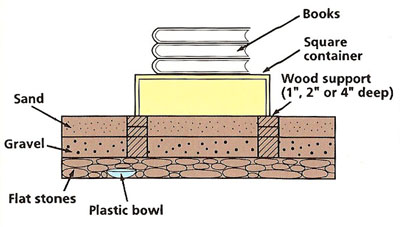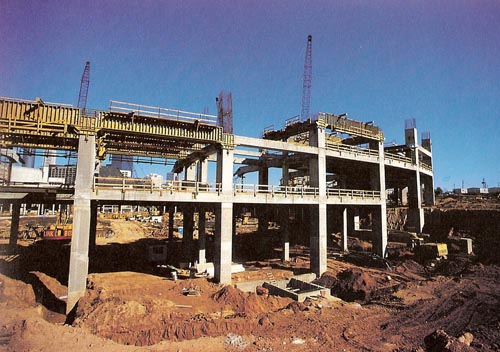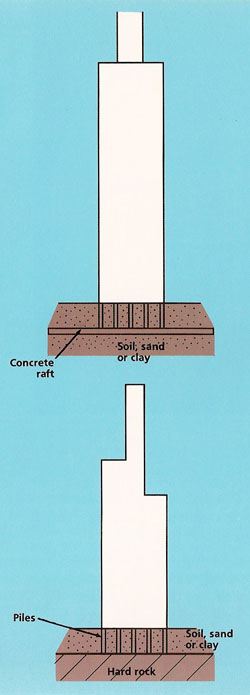SPIDERWEBS TO SKYSCRAPERS: The Science of Structures - 1. Preparing the Ground

Figure 1. The Sears Tower (center left) soars above the city of Chicago.

Figure 2. A Roman aqueduct built over 2,000 years ago.

Figure 3. Experimenting with foundations.

Figure 4. The foundations of the Georgia Dome in Atlanta.
Structures, large and small, are all around us and serve many different purposes. The ones we tend to think of first are those that people have made, such as houses, bridges, dams, and skyscrapers. Certainly, these can be very spectacular. The Sears Tower in Chicago, for instance, soars 110 stories and 1,454 feet above street level (see Figure 1). Twin television masts on the roof takes its total height to eighteen hundred feet, or over a third of mile.
However, there are also many amazing natural structures. Spiders' webs, birds' nests, trees, caves, and mountains are just some of the "buildings" that are put up without any human help. In fact, we could not be builders ourselves if it were not for our skeleton – that vital structure inside each one of us.
Basics of Building
A structure is simply a thing or a framework that provides support. It might be a bridge that helps hold up a road across a river (see Figure 2). Or it might be a house that gives support to the roof and ceiling over our heads.
If the structure is a good one it will be strong enough to stand up to all the forces that are likely to act on it over a long period of time. This requires careful planning and design. Which shapes and arrangements of parts are best suited to the task? What materials should be used?
We also need to think about what a structure will rest upon. How can a building be prevented from simply sinking under its own weight?

The Need for SupportYou will need:
What to do:
Pack the flat stones tightly in the bottom of the bowl to a depth of 2". On top of this put a 2" layer of gravel and, finally, a 2" layer of sand. Make sure that each layer is smooth and even.
On the side of the container mark a scale in tenths of an inch, starting from zero at the open end. Place the open end of the container lightly on the surface of the sand. Its sides represent the outer walls of a building. Gently place one of the books on top of the container. The weight of the book represents the downward load acting on the walls (see Figure 3). Look at the scale on the side of the container and write down how much the walls have sunk into the sand. Add several more books, one at a time, and repeat the measurement each time.
Remove the container. Take the four smallest pieces of wood and push them into the sand along the lines made by the sides of the container. The top of the wood should be exactly level with the surface of the sand. Place the container so that its walls sit on the wooden "foundations." Again, gradually load the container with books and after adding each book, measure the amount by which the walls have sunk.
Remove the container and the 1" pieces of wood. Repeat the experiment with the 2" pieces and the 4" pieces. Try to explain what you find. Plot your results in the form of a graph.
Taking it further:
Place the sheet of cardboard 1" under the surface of the sand. Make sure it is level. Push in the 1" pieces of wood so that they rest on the cardboard. Place the container on the wood and load it with books, one at a time, measuring how much the walls sink as the load is increased. Compare the results with those you obtained earlier for the 1� pieces without the cardboard underneath. What can you deduce from this? |
Firm Foundations
The bigger and heavier a building is, the more it pushes on the ground beneath it. Because of this, all but the lightest structures must sit in specially prepared supports known as FOUNDATIONS (see Figure 4).
The soft upper layers of soil are dug away from below where the structure will stand. In the case of an ordinary house, trenches several feet deep are dug along the lines of the supporting walls. Then these trenches are filled with concrete that quickly sets hard.
Larger, heavier structures, such as bridges and skyscrapers, need much deeper foundations to prevent them from sinking. Just how deep the foundations have to be depends on the makeup of the ground beneath the site. Where the ground is soft, the foundations must go down a long way. If there is solid rock near the surface, on the other hand, the foundation can sit directly on it.
Skyscraper Cities
 |
| These drawings show a foundation made with
a thick raft of concrete (top), and another constructed with piles
driven into rock .
|
Huge skyscrapers such as those in New York City would have been impossible to build in cities such as Houston, Texas, or London, England, until quite recently. The reason is that the island of Manhattan consists almost entirely of bare granite – a very hard and strong type of rock. Houston and London, on the other hand, rest on thick beds of soft clay.
To carry the weight of a building such as a skyscraper, special foundations known as "piles" are used. These are concrete or steel columns hammered into the ground until they penetrate solid rock or hard-packed soil. Alternatively, piles can be made by boring shafts into the ground and failing them with fresh concrete.
If the underlying rock or firm soil lies too deep to reach with ordinary foundations, engineers may put down a thick raft of concrete right across the site. This spreads the load as widely as possible over the weak soil.

